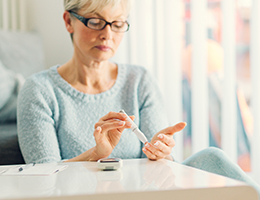
Feeling sick isn't fun. When you have an illness like a cold or the flu, your first priority is often getting plenty of rest—and that's a good thing. But if you have diabetes, you also need to focus on your blood sugar.
Why? Even a minor illness can make diabetes harder to manage. And that can have serious consequences.
Being sick can raise your blood sugar
Illnesses such as colds and the flu stress your body, which causes it to produce hormones. These help your body fight the illness, but they can also raise your blood sugar levels, according to the American Diabetes Association (ADA). This can make it hard to keep your blood sugar in a healthy range when you're sick.
If you're vomiting, that adds the risk of dehydration, which can also make blood sugar rise.
And in some cases, problems with your glucose or insulin levels can lead to ketoacidosis. This condition happens when the body begins burning its own fat for energy, producing acids called ketones. Untreated, it can cause a diabetic coma.
You can avoid these serious conditions by giving yourself some extra care when you're sick.
Have a sick day plan
Since everyone gets sick sometimes, it's a good idea to prepare. Start by asking your diabetes care team what to do when you become ill. According to the National Institute of Diabetes and Digestive and Kidney Diseases (NIDDK) and other experts, your sick-day plan may include steps like these:
Check your blood sugar levels more often. Typically, that's at least every four hours. Keep track of your results. You may need to report them to your healthcare team. And make sure you always have enough testing supplies on hand to get you through an illness.
Check your ketones. If you are told to check your ketones when you're ill, you can do this with a simple urine test strip.
Adjust your insulin dose, if you use insulin. It's important to keep taking all of your diabetes medicines, even if you don't feel good. Don't wait until the last minute to refill prescriptions in case you're too sick to go to the pharmacy.
Stay hydrated by drinking plenty of water. If you're having trouble keeping anything down, try just sipping a drink.
Stick to your normal meal plan as much as possible. If you don't feel like eating or drinking, try foods or drinks that are easy on the stomach. Good options include canned soups, crackers, gelatin, dry toast, fruit, juices, milk and yogurt. Keep foods like these on hand to help you avoid a low blood sugar episode.
When to get help
Even with the best at-home care, you may still need help. Keep the phone numbers for your doctor, diabetes educator and dietitian handy in case you have questions about caring for yourself. According to the ADA and the NIDDK, you should call your doctor right away if you:
- Have a blood sugar level above 240 even after taking your diabetes medicine.
- Have a fever over 101 degrees for 24 hours.
- Have diarrhea for more than six hours.
- Vomit more than once.
- Are not sure what to do to take care of yourself.
- Have above-normal ketone levels.
Get urgent help if you have symptoms of ketoacidosis or dehydration, such as dry mouth, confusion, drowsiness, trouble breathing, flushed or dry skin, frequent urination, or a fruity odor on your breath. If any of these occur, seek medical attention right away.
An ounce of prevention
You can help keep colds and other illnesses at bay by washing your hands often and avoiding people who are ill. Get a flu shot every year, and ask your doctor if you need a pneumonia vaccine too.
Learn more about managing diabetes in our Diabetes health topic center.
Reviewed 8/15/2025